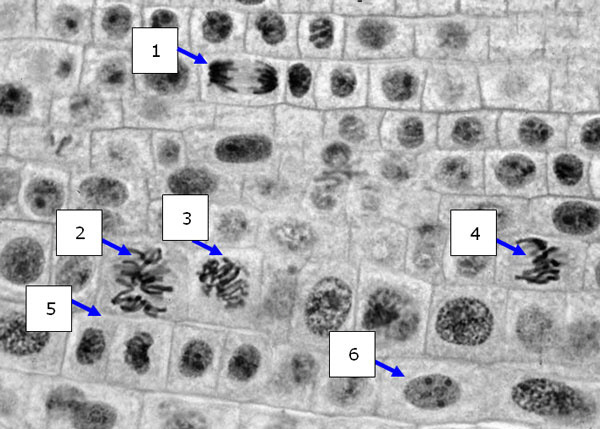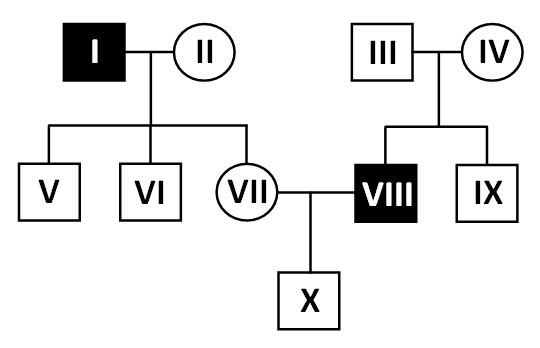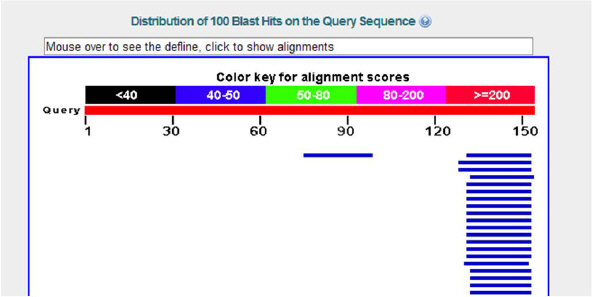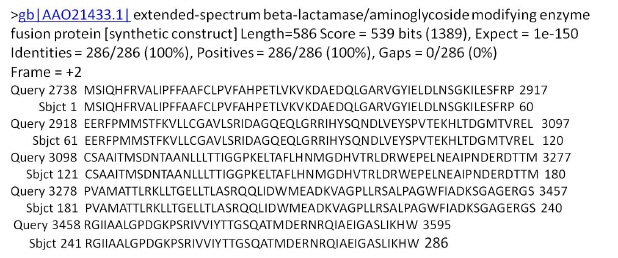Multiple Choice
Identify the choice that best completes the
statement or answers the question.
|
|
|
1.
|
Which one of the following is false?
a. | The genetic makeup of an organism constitutes its genotype. | b. | The expressed
physical traits of an organism are called its phenotype. | c. | Alleles are
alternate forms of a gene. | d. | An organism with two different alleles for a
single trait is said to be heterozygous. | e. | An allele that is fully expressed is referred
to as recessive. |
|
|
|
2.
|
Alleles of a gene are found at __________ chromosomes.
a. | different loci on heterologous | b. | the same locus on
heterologous | c. | different loci on homologous | d. | the same locus on homologous
mitochondrial | e. | the same locus on homologous |
|
|
|
3.
|
A carrier of a genetic disorder who does not show symptoms is most likely to be
__________ to transmit it to offspring.
a. | homozygous for the trait and unable | b. | homozygous for the trait and
able | c. | heterozygous for the trait and able | d. | heterozygous for the trait and
unable | e. | None of the choices are correct. |
|
|
|
4.
|
The vast majority of people afflicted with recessive disorders are born to
parents who were
a. | not affected at all by the disease. | b. | subjected to some environmental toxin that
caused the disease in their children. | c. | slightly affected by the disease, showing some
but not all of the symptoms. | d. | both affected by the
disease. | e. | None of the choices are correct. |
|
|
|
5.
|
A person with AB blood illustrates the principle of
a. | pleiotropy. | b. | incomplete dominance. | c. | blending
inheritance. | d. | codominance. | e. | polygenic
inheritance. |
|
|
|
6.
|
Crossing over __________ genes into assortments of __________ not found in the
parents.
a. | combines unlinked . . . alleles | b. | recombines linked . . .
alleles | c. | combines linked . . . genes | d. | recombines unlinked . . .
genes | e. | recombines unlinked . . . chromosomes |
|
|
|
7.
|
How many sex chromosomes are in a human gamete?
a. | four | b. | five | c. | three | d. | one | e. | two |
|
|
|
8.
|
Any gene located on a sex chromosome
a. | will exhibit pleiotropy. | b. | is called a sex-linked
gene. | c. | will exhibit codominance. | d. | is called a recessive gene. | e. | is called a dominant
allele. |
|
|
|
9.
|
Why are sex-linked conditions more common in men than in women?
a. | Women simply do not develop the disease regardless of their genetic
composition. | b. | The sex chromosomes are more active in men than in women. | c. | Men acquire two
copies of the defective gene during fertilization. | d. | Men need to inherit only one copy of the
recessive allele for the condition to be fully expressed. | e. | None of the choices
are correct. |
|
|
|
Answer the following questions based on the diagram below:
|
|
|
10.
|
Order the stages of the cell cycle correctly.
a. | 1, 4, 3, 2. | b. | 1, 2, 4, 3. | c. | 1, 3, 4,
2. | d. | 4, 1, 2, 3. | e. | 4, 3, 1, 2. |
|
|
|
11.
|
Which stage is characterized by the condensing of DNA into chromosomes and the
breakdown of the nuclear membrane?
a. | 1 | b. | 2 | c. | 3 | d. | 4 | e. | None of the
above. |
|
|
|
The following diagram shows a cross section of a plant root tip. Answer
the questions based on your ability to identify the stage of the cell cycle the cells are in. 
|
|
|
12.
|
Which cell is most likely to be in interphase?
|
|
|
13.
|
Process (4) is:
a. | Interphase. | b. | Metaphase. | c. | Anaphase. | d. | Telophase. | e. | Meiosis. |
|
|
|
The following graph tracks the amount of DNA in a single nucleus through the
cell cycle. Answer the questions based on the graph.
|
|
|
14.
|
Stages I, II, and III are part of:
a. | Interphase | b. | Prophase | c. | Metaphase | d. | Mitosis | e. | Meiosis |
|
|
|
15.
|
Sister chromatids are found in which of the following stages?
a. | I | b. | V | c. | VI | d. | VII | e. | Both (I) and
(V) |
|
|
|
The following graph tracks the amount of DNA in a single nucleus through the
process of meiosis. Answer the questions based on the graph.
|
|
|
16.
|
Meiosis I is which group of the following stages?
a. | I, II, III | b. | IV, V, VI, VII | c. | VIII, IX, X,
XI | d. | I, II, III, IV, V, VI, VII | e. | None of the above
combinations |
|
|
|
17.
|
Which of the following statements is false?
a. | Tetrads form during IV. | b. | Cells are diploid during
IV. | c. | Cells are diploid during XII. | d. | DNA is replicated once during this
process. | e. | The cell divides twice during this process. |
|
|
|
18.
|
During which stage is the amount of DNA in the cell characterized as 1n?
a. | I | b. | IV | c. | VII | d. | XII | e. | None of the
above. |
|
|
|
The following pedigree shows the inheritance of an autosomal genetic disorder
inherited in simple Mendelian patterns. 
|
|
|
19.
|
Determine if the genetic disorder is dominant or recessive. Which
individual can possibly be a NON-carrier of the allele causing the disorder.
a. | III | b. | V | c. | IX | d. | X | e. | All individuals
above must have at least one copy of the affected allele. |
|
|
|
The following pedigree shows the inheritance of an X-linked recessive
disorder.
|
|
|
20.
|
Which individual does not have the recessive allele?
a. | I | b. | IV | c. | V | d. | IX | e. | Both V and
IX. |
|
|
|
|
|
|
21.
|
Observe the diagram carefully. Which of the following appropriately describes
the relationship between “a” and “A” as well as the relationship between
“a” and “b”
a. | The “A” and “a” are the same gene and the same allele whereas
a and “b” are different loci but same gene | b. | “A” and “a” are at the
same loci but different alleles whereas “a” and “b” arelocated
different loci and therefore carry different genes | c. | “A” and “a” are carried
on homologous chromosomes and “a” and “b” are carried on sister
chormatids. | d. | “A” and “a” are different alleles for the same gene but
“a” and “b” are different genes. | e. | Both b and d are
correct |
|
|
|
22.
|
Which of the following correctly pairs the identification numbers to the
appropriate definition?
a. | 1....2 are homologous to each other | b. | 1....5 are homologous to each other | c. | 3....4 are identical to each other | d. | 1....2 are identical
to each and are a result of DNA replication | e. | both b and d are
correct |
|
|
|
23.
|
Where must crossing over occur to result in a chromosome with the following
combination of alleles:
-D a b C-
a. | Crossing over should occur between points 1-2 and 8-9 | b. | Crossing over should
occur between points 8-9 and 11 to the end of the chromosome | c. | Crossing over should
occur between points 10-11 | d. | Crossing over should occur 11 and the end
| e. | None of the above are correct. |
|
|
|
24.
|
Which of the following choices are correct?
a. | 3 and 4 denote members of a tetrad | b. | 1 and 2 are
identical to each other | c. | 1 and 5 are homologous to each
other | d. | 3 is homologous to 4 | e. | all of the above are
correct |
|
|
|
25.
|
Consider the order of events in meiosis. The following statements are
events in the process of meiosis. Which of the following choices put the statement in the correct
sequence of events.
I. 1 and 2 separate during a division in meiosis
II. Exchange may occur
between point 10-11 between chromosomes 1 and 5
III. 3 separates from 4 during a division in
meiosis
IV. 1 and 5 replicate
a. | IV.....III....II....1 | b. | III....IV....II.....I | c. | IV....II.....III.....I | d. | II.....III.....II.....IV | e. | II.....IV....II....IV |
|
|
|
26.
|
Cells two sets of genetic information are described by the term
a. | polyploid. | b. | diploid. | c. | triploid. | d. | haploid. | e. | tetraploid. |
|
|
|
|
|
|
27.
|
Observe clone number 1. Which observation(s) can be made about the gel
electrophoresis of this clone?
a. | The clone has an insert of approximately 300 base pairs.(+/- 50
bases) | b. | The clone shows contamination- most likely from picking two colonies from the plate
that were two close together. | c. | The clone shows a PCR product of approximately
500 bases. | d. | The digest lane and the PCR lane “agree” about the size of the
insert. | e. | A, C and D are correct |
|
|
|
28.
|
Consider clone number 4. Compare the cut and the PCR lanes. What are
possible observations regarding this clone?
a. | There is single large insert with and an internal restriction site on the
insert. | b. | There is a single large insert | c. | There is contamination- the PCR lane confirms
this with two different sized fragments | d. | There is a single large insert and primer dimer
in the cut lanes | e. | bothe a and d are correct |
|
|
|
29.
|
Note the following amino acid sequence:
1 malwmrllpl lallalwgpd paaafvnqhl
cgshlvealy lvcgergffy tpktrreaed lqvgqvelgg gpgagslqpl alegslqkrg iveqcctsic slyqlenycn 109
Using the bioinformatic tools Such as Blast P, which of the following does the above
sequence most likely code for?
a. | Insulin | d. | cytochrome C | b. | glucagon | e. | none of the above | c. | acetylcholinesterase |
|
|
|
30.
|
Using PDB id: 2hui which of the following is correct information about this
structure?
a. | There are three beta sheets present in the three dimensional structure of this
protein | b. | There are three alpha sheets present in the three dimensional structure of this
protein. | c. | This is an insulin molecule with three alpha helixes | d. | This is a nucleotide
sequence showing three dimensional form with secondary structure | e. | Both A and B are
correct
|
|
|
|
Blast N A nucleotide sequence was entered into blast N, and blasted again the
nr/nt database and the following is the graphical representation of that match. 
|
|
|
31.
|
Which of the following are correct conclusions, that can be drawn from the
results shown above?
a. | This nucleotide sequence has significant matches within the
database. | b. | This nucleotide sequence has areas of significant identity with entries in the
database. | c. | This nucleotide sequence has little areas of homology to entries in the
database | d. | Assuming this is the correct sequence that you entered into the database, based on
this result only, you may have found a novel nucleotide sequence. | e. | Both C and D are
true |
|
|
|
|
|
|
32.
|
You have completed a BLAST on your cDNA from Wolfia austrailiana against
the nr/nt database. Which of the above notations (1-5) corresponds to YOUR cdna sequence?
|
|
|
33.
|
Which the above notations (1-5) corresponds to the “best” match to
your cDNA sequence?
|
|
|
34.
|
Using the labeled Blast N results page above, how long is your sequence of
nucleotides?
a. | The question is incorrect. The above shows amino acid blast
results. | b. | The sequence is over 10 nucleotides long | c. | The sequence is over
100 nucleotids long. | d. | The sequence is over 150 nucleotides
long. | e. | The sequence is over 200 base pairs long |
|
|
|
Blast X Results: 
|
|
|
35.
|
You have put in a nucleotide sequence and received the following alignment in
your blast X results page. Which of the following statements are true?
a. | The program has found the best ORF in the +1 reading frame. | b. | The nucleotide
sequence does NOT look like it codes for a matching protein within the database. | c. | The results show
that your nucleotide sequence most likely codes for beta-lactamase is in the +2 reading
frame. | d. | You most likely are missing the start of the ORF in your nucleotide
sequence. | e. | all of the above are true | f. | none of the above are
true |
|
|
|
|
|
|
36.
|
Which of the above notations shows cDNA insert?
a. | 1 | b. | 2 | c. | 3 | d. | 4 | e. | two of the
above correspond to cDNA insert. |
|
|
|
37.
|
Which of the above notations corresponds to the first base of cDNA insert?
a. | 1 | b. | 2 | c. | 3 | d. | 4 | e. | none of the
above |
|
|
|
|
|
|
38.
|
Given the above blast results, which of the following statements is FALSE?
a. | Your nucleotide sequence is about 4500 bases long. | b. | You have a
significant match from 2,700 bases to 3550 bases | c. | You have a significant match at 200th
nucleotide to the end of the sequence | d. | Most of the query sequence does not have a good
match except for about 1,000 bases. | e. | All of the above are
false. |
|
|
|
39.
|
Which of the following best explains a BLAST X?
a. | A blast X takes an amino acid sequence and translates the sequence into peptide
sequence. | b. | A BLAST X takes a nucleotide sequence and compare this sequences to all other
nucleotide sequences in the database | c. | A BLAST X takes a nucleotide sequence and
translates this sequence and translates this sequence into amino acids. This peptide sequence is then
compared and aligned protein sequence in the database. | d. | A Blast X shows all the reading frame
translations. | e. | A and B are both correct descriptions of Blast X |
|
|
|
40.
|
According to Mendel, what kind of genes "disappear" in
F1 pea plants?
a. | sex-linked | b. | dominant | c. | recessive | d. | codominant | e. | lethal |
|
|
|
41.
|
If tall (D) is dominant to dwarf (d), and two homozygous varieties
DD and dd are crossed, then what kind of offspring will be produced?
a. | all intermediate forms | b. | all tall | c. | all
dwarf | d. | 1/2 tall, 1/2 dwarf | e. | 3/4 tall, 1/4
dwarf |
|
|
|
42.
|
If all the offspring of a testcross are alike and resemble the organism being
tested, then that parent is
a. | homozygous dominant. | b. | homozygous recessive. | c. | heterozygous. | d. | recessive. | e. | incompletely
dominant. |
|
|
|
43.
|
In cocker spaniels, black coat color (B) is dominant over red (b),
and solid color (S) is dominant over spotted (s). If two black solid dogs were crossed
several times and the total offspring were eighteen black solid and five black spotted puppies, the
genotypes of the parents would most likely be
a. | Bb Ss x Bb Ss. | b. | Bb Ss x Bb
SS. | c. | BB Ss x Bb ss. | d. | BB Ss x Bb
Ss. | e. | Bb ss x Bb SS. |
|
|
|
44.
|
If all the offspring of a cross had the genotype Aa Bb, the parents of
the cross would most likely be
a. | AA BB x aa bb. | b. | AA bb x aa
BB. | c. | Aa Bb x Aa Bb. | d. | Aa bb x aa
Bb. | e. | both AA BB x aa bb and AA bb x aa
BB. |
|
|
|
45.
|
Susan, a mother with type B blood, has a child with type O blood. She claims
that Craig, who has type A blood, is the father. He claims that he cannot possibly be the father.
Further blood tests ordered by the judge reveal that Craig is AA. The judge rules that
a. | Susan is right and Craig must pay child support. | b. | Craig is right and
doesn't have to pay child support. | c. | Susan cannot be the real mother of the child;
there must have been an error made at the hospital. | d. | it is impossible to reach a decision based on
the limited data available. | e. | none of these |
|
|
|
|
46.
|
Four of the five answers listed below are pure breeding. Select the
exception.
| a. |
AA
BB |
| b. |
Aa
BB |
| c. |
AA
bb |
| d. |
aa
BB |
| e. |
aa
bb |
| |
|
Other
|
|
|
47.
|
Answer the following questions based on this diagram:
Which statement is true?
a. The
karyotype was taken from a male.
b. The karyotype shows 22
chromosomes.
c. The karyotype belongs to an individual with trisomy
21.
d. The DNA shown here must have been taken from a cell in
interphase.
e. Each chromosome is made up of multiple DNA
strands.
|
|
|
48.
|
The cause of the above disorder is most
likely:
a. Genetic mutation in DNA
sequence.
b. Cells inability to complete cytokinesis after
mitosis.
c. Nondisjunction during
meiosis.
d. Nondisjunction during
mitosis.
e. This individual does NOT have a genetic disorder.
|